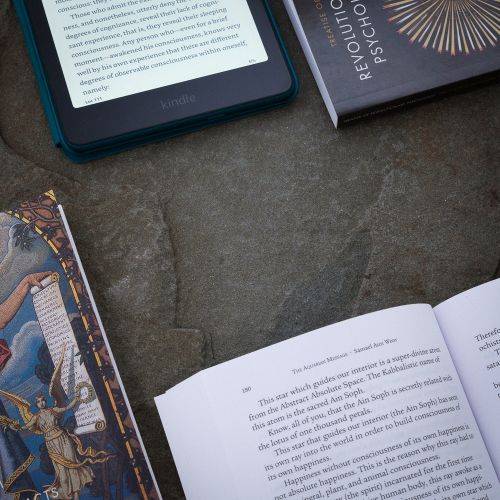Flood, the Deluge of Noah, Deukalion, and Manu Vaivasvatta
Most famous from the Judeo-Christian story of Noah and the ark, the universal flood was an actual event recorded in hundreds of cultures around the world, yet has also been mixed and confused with many such floods and deluges.
"The "Deluge" is undeniably an universal tradition. "Glacial periods" were numerous, and so were the "Deluges," for various reasons. Stockwell and Croll enumerate some half dozen Glacial Periods and subsequent Deluges -- the earliest of all being dated by them 850,000, and the last about 100,000, years ago.* But which was our Deluge? Assuredly the former, the one which to this date remains recorded in the traditions of all the peoples, from the remotest antiquity; the one that finally swept away the last peninsulas of Atlantis, beginning with Ruta and Daitya and ending with the (comparatively) small island mentioned by Plato. This is shown by the agreement of certain details in all the legends. It was the last of its gigantic character. The little deluge, the traces of which Baron Bunsen found in Central Asia, and which he places at about 10,000 years B.C., had nothing to do with either the semi-universal Deluge, or Noah's flood -- the latter being a purely mythical rendering of old traditions -- nor even with the submersion of the last Atlantean island; at least, only a moral connection. Our Fifth Race (the non-initiated portions), hearing of many deluges, confused them, and now know of but one. This one altered the whole aspect of the globe in its interchange and shifting of land and sea. We may compare the traditions of the Peruvians: -- "The Incas, seven in number, have repeopled the Earth after the deluge," they say (Coste I, IV., p. 19); Humboldt mentions the Mexican version of the same legend, but confuses somewhat the details of the still-preserved legend concerning the American Noah. Nevertheless, the eminent Naturalist mentions twice seven companions and the divine bird which preceded the boat of the Aztecs, and thus makes fifteen elect instead of the seven and the fourteen. This was written probably under some involuntary reminiscence of Moses, who is said to have mentioned fifteen grandsons of Noah, who escaped with their grandsire. Then again Xisuthrus, the Chaldean Noah, is saved and translated alive to heaven -- like Enoch -- with the seven gods, the Kabirim, or the seven divine Titans; again the Chinese Yao has seven figures which sail with him and which he will animate when he lands, and use for "human seed." Osiris, when he enters the ark, or solar boat, takes seven Rays with him, etc., etc." —HP Blavatsky, The Secret Doctrine [1888]
The myths and legends of the universal flood use historical events to convey allegorical truths. That is, there is meaning on the historical level, and there are also deeper and more important meanings.
"The History of the Races begins at the separation of the Sexes, when the preceding egg-bearing androgynous race perished rapidly, and the subsequent sub-races of the Third Root-Race appeared as an entirely new race physiologically. It is this "destruction" which is called allegorically the great "Vaivasvata Manu Deluge," when the account shows Vaivasvata Manu (or "Humanity") remaining alone on Earth in the Ark of Salvation towed by Vishnu in the shape of a monstrous fish, and the Seven Rishis "with him." The allegory is very plain: --
"In the Symbolism of every nation, the "Deluge" stands for Chaotic unsettled matter -- Chaos itself: and the Water for the feminine principle -- the "Great Deep." As the Greek Lexicon of Parkhurst gives it -- "Arche (ark) answers to the Hebrew rasit, or Wisdom . . . . and (at the same time) to the emblem of the female generative power, the Arg or Arca, in which the germ of nature (and of mankind) floats or broods on the great Abyss of the waters, during the interval which takes place after every mundane (or racial) cycle." Ark is also the mystic name of the divine spirit of life which broods over chaos. Now Vishnu is the divine Spirit, as an abstract principle, and also as the Preserver and Generator, or Giver of life -- the third person of the Trimurti (composed of Brahma, the Creator, Siva, the Destroyer, and Vishnu, the Preserver). Vishnu is shown in the allegory as guiding, under the form of a fish, the Ark of Vaivasvata Manu clean across the waters of the Flood. There is no use in expatiating upon the esoteric meaning of the word fish. (See Payne Knight, Inman, Gerald Massey, etc.) Its theological meanings is phallic, but the metaphysical, divine. Jesus is called the "Fish," and so were Vishnu and Bacchus: [[Ies]], the "Saviour" of mankind, being but the monogram of the god Bacchus called [[Ichthus]], the fish.* As to the Seven Rishis in the Ark, they symbolised the seven principles, which became complete in man only after he had separated, and become a human, and no longer a divine creature. (See for further details, "The Seventh Manu.")
"Nor have we many details about the submersion of the continent inhabited by the Second Root Race. But the history of the Third, "Lemuria," is given, as is that of Atlantis, the others being only alluded to. Lemuria is said to have perished about 700,000 years before the commencement of what is now called the Tertiary age (the Eocene),** and it is during this Deluge also -- an actual geological deluge this time -- that Vaivasvata Manu is again shown as saving mankind (allegorically it is mankind, or a portion of it, the Fourth Race, which is saved); so also he saves the Fifth Race during the destruction of the last Atlanteans, the remnants that perished 850,000 years ago,* after which there was no great submersion until the day of Plato's Atlantis, or Poseidonis, known to the Egyptians only because it happened in such relatively recent times.
"It is the submersion of the great Atlantis which is the most interesting. It is of this cataclysm that the old records (See the "Book of Enoch") say that "the ends of the Earth got loose;" and upon which the legends and allegories of Vaivasvata, Xisuthrus, Noah, Deukalion and all the tutti quanti of the Elect saved, have been built. Tradition, taking into no account the difference between sidereal and geological phenomena, calls both indifferently "deluges." Yet there is a great difference. The cataclysm which destroyed the huge continent of which Australia is the largest relic, was due to a series of subterranean convulsions and the breaking asunder of the ocean floors. That which put an end to its successor -- the fourth continent -- was brought on by successive disturbances in the axial rotation. It began during the earliest tertiary periods, and, continuing for long ages, carried away successively the last vestige of Atlantis, with the exception, perhaps, of Ceylon and a small portion of what is now Africa. It changed the face of the globe, and no memory of its flourishing continents and isles, of its civilizations and sciences, remained in the annals of history, save in the Sacred records of the East." —HP Blavatsky, The Secret Doctrine [1888]
"Once it came into the mind of Zeus to destroy this fourth race [the Atlanteans] and to leave the Earth to the nymphs and the satyrs. He would destroy it by a great flood. But Prometheus, the Titan who had given aid to Zeus--Prometheus who was named the Forethinker--would not consent to the race of men being destroyed utterly, and he considered a way of saving some of them. To a man and a woman, Deukalion and Pyrrha, just and gentle people, he brought word of the plan of Zeus, and he showed them how to make a ship that would bear them through what was about to be sent upon the Earth. Then Zeus shut up in their caves all the winds except the wind that brings rain and clouds. He bade this wind, the South Wind, sweep over the Earth, flooding it with rain. He called upon Poseidon and bade him let the sea pour in on the land. And Poseidon commanded the rivers to put forth all their strength, and sweep dykes away, and overflow their banks. The clouds and the sea and the rivers poured upon the Earth. The flood rose higher and higher, and in places where pretty lambs had gambolled the ugly sea-calves now played; men in their boats drew fishes out of the tops of elm-trees, and the water-nymphs were amazed to come on men's cities under the waves. Soon even the men and women who had boats were overwhelmed by the rise of the water--all perished then except Deukalion and Pyrrha, his wife; them the waves had not overwhelmed--they were in a ship that Prometheus had shown them how to build. The flood went down at last, and Deukalion and Pyrrha climbed up to a high and a dry ground. Zeus saw that two of the race of men had been left alive. But he saw that these two were just and kindly and had a right reverence for the Gods. He spared them, and he saw their children again peopling the Earth." —Orpheus, Myths of the World by Padraic Colum [1930]





